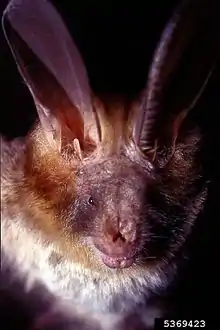Nycteris
Nycteris comprises a genus of bats commonly called slit-faced or hollow-faced bats. They are grouped in the family Nycteridae. The bats are found in East Malaysia, Indonesia, and many parts of Africa.
| Nycteris | |
|---|---|
 | |
| Egyptian slit-faced bat (Nycteris thebaica) | |
| Scientific classification | |
| Kingdom: | Animalia |
| Phylum: | Chordata |
| Class: | Mammalia |
| Order: | Chiroptera |
| Family: | Nycteridae Hoeven, 1855 |
| Genus: | Nycteris G. Cuvier & E. Geoffroy Saint-Hilaire, 1795 |
| Species | |
They are small bats, from 4 to 8 centimetres (1.6 to 3.1 in) in body length, and with grey, brown, or reddish fur. A long slit runs down the centre of their faces from between the eyes to the nostrils, and probably assists in echolocation. They have large ears, and a complex nose-leaf. Their tails end in a T-shape, formed from cartilage, a unique feature among mammals.[1] Their dental formula is:
| Dentition |
|---|
| 2.1.1.3 |
| 3.1.2.3 |
Slit-faced bats roost in caves, trees, and buildings, typically in fairly small colonies. Some even roost in animal burrows, such as those of hedgehogs or porcupines. They eat insects, and some terrestrial invertebrates, such as spiders and small scorpions. At least one species, the large slit-faced bat, even catches vertebrate prey, such as frogs and small birds.[2]
The echolocation calls of slit-faced bats are relatively quiet and short in duration, and they seem to target their prey by hearing the sounds it produces, rather than by sonar.[2] They give birth once or twice each year.
Classification
Most sources report 13 species. However, 16 have been described. Those of indeterminate status are marked with "?" in the list below.
Family Nycteridae
- Genus Nycteris
- Bate's slit-faced bat, N. arge
- Andersen's slit-faced bat, N. aurita
- Gambian slit-faced bat, N. gambiensis
- Large slit-faced bat, N. grandis
- Hairy slit-faced bat, N. hispida
- N. h. hispida
- N. h. pallida
- Intermediate slit-faced bat, N. intermedia
- Javan slit-faced bat, N. javanica
- Large-eared slit-faced bat, N. macrotis
- N. m.aethiopica
- N. m. macrotis
- N. m.luteola
- Malagasy slit-faced bat, N. madagascariensis
- Ja slit-faced bat, N. major
- N. m. avakubia
- N. m. major
- Dwarf slit-faced bat, N. nana
- N. n.nana
- N. n.tristis
- Egyptian slit-faced bat, N. thebaica
- N. t. adana
- N. t. albiventer
- N. t. capensis
- N. t. damarensis
- N. t. najdiya
- N. t. thebaica
- Malayan slit-faced bat, N. tragata
- Parissi's slit-faced bat, N. parisii ?
- Vinson's slit-faced bat, N. vinsoni
- Wood's slit-faced bat, N. woodi
References
- Macdonald, D., ed. (1984). The Encyclopedia of Mammals. New York: Facts on File. p. 804. ISBN 0-87196-871-1.
- Fenton, M. Brock (2001). Bats. New York: Checkmark Books. pp. 125–127. ISBN 0-8160-4358-2.
- Data from funet.ni
- IUCN 2006. 2006 IUCN Red List of Threatened Species. Downloaded on 13 April 2007.
Further reading
Abdullah MT. 2003. Biogeography and variation of Cynopterus brachyotis in Southeast Asia. PhD thesis. The University of Queensland, St Lucia, Australia.
Corbet, GB, Hill JE. 1992. The mammals of the Indomalayan region: a systematic review. Oxford University Press, Oxford.
Hall LS, Gordon G. Grigg, Craig Moritz, Besar Ketol, Isa Sait, Wahab Marni and M.T. Abdullah. 2004. Biogeography of fruit bats in Southeast Asia. Sarawak Museum Journal LX(81):191-284.
Karim, C., A.A. Tuen and M.T. Abdullah. 2004. Mammals. Sarawak Museum Journal Special Issue No. 6. 80: 221—234.
Mohd. Azlan J., Ibnu Maryanto, Agus P. Kartono and M.T. Abdullah. 2003 Diversity, Relative Abundance and Conservation of Chiropterans in Kayan Mentarang National Park, East Kalimantan, Indonesia. Sarawak Museum Journal 79: 251-265.
Hall LS, Richards GC, Abdullah MT. 2002. The bats of Niah National Park, Sarawak. Sarawak Museum Journal. 78: 255-282.
Wilson DE, Reeder DM. 2005. Mammal species of the world. Smithsonian Institution Press, Washington DC.